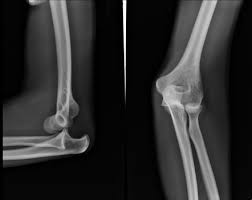65 years old female presented to our A&E department with h/o elbow injury following a fall (FOOSH) . She had obvious deformity of elbow joint but there were no neurovascular deficits. X rays confirmed posterior dislocation but there was no fracture. Dislocation was reduced in A&E under procedural sedation.
Elbow dislocation is not so uncommon, but it was the second time I came across this condition in my clinical practice and hence I decided to learn bit more about this condition.
My learning:
The elbow joint consists of the humeroulnar and humeroradial joints, which aid in the flexion and extension of the elbow [1]
It is among the most common large joints to dislocate. Dislocations may be isolated or involve damage to static supportive structures of the elbow and may even cause fractures above the elbow.{2}
Procedures for elbow reduction
These YouTube videos (bottom of this page) describe two different techniques for reduction of posterior elbow dislocation. I found them very useful.
The arm should be initially extended to 30° flexion. The overall gross alignment of the elbow is then manipulated so that the olecranon appears centred between the medial and lateral condyle of the humerus. The forearm is then slowly flexed to approximately 90° with the physician providing longitudinal traction to the forearm while the assistant provides countertraction to the patient’s humerus. The arm is then flexed even further with direct downward pressure applied to the olecranon.
Upon reduction, the arm is placed in a posterior splint at 90° flexion with neutral rotation of the forearm.
Several studies have shown better outcomes with early mobilisation than with immobilisation in patients with simple dislocations [3] [4]
Reference:
1.https://www.uptodate.com/contents/surgical-management-of-severe-upper-extremity-injury?search=elbow%20dislocation&source=search_result&selectedTitle=4~20&usage_type=default&display_rank=4
2.Hackl M, Beyer F, Wegmann K, Leschinger T, Burkhart KJ, Müller LP. The treatment of simple elbow dislocation in adults. Dtsch Arztebl Int. 2015 May 1;112(18):311-9. doi: 10.3238/arztebl.2015.0311. PMID: 26037467; PMCID: PMC4455254.

